On Okinawa, two regiments of US 6th Marine Division make landings on the Oroku peninsula in an attempt to outflank Japanese defensive positions.
The battle line on Oroku Peninsula, 4-13 June 1945
However, this is the base area of the Japanese Navy on Okinawa. The local IJN commander, after at first obeying orders to retreat to the Kiyan line, dislikes his new position. He disobeys orders and has his troops reoccupy their original cave positions at Oroku.
The 32nd Army papers over the mutiny by sending orders after wards approving this action.
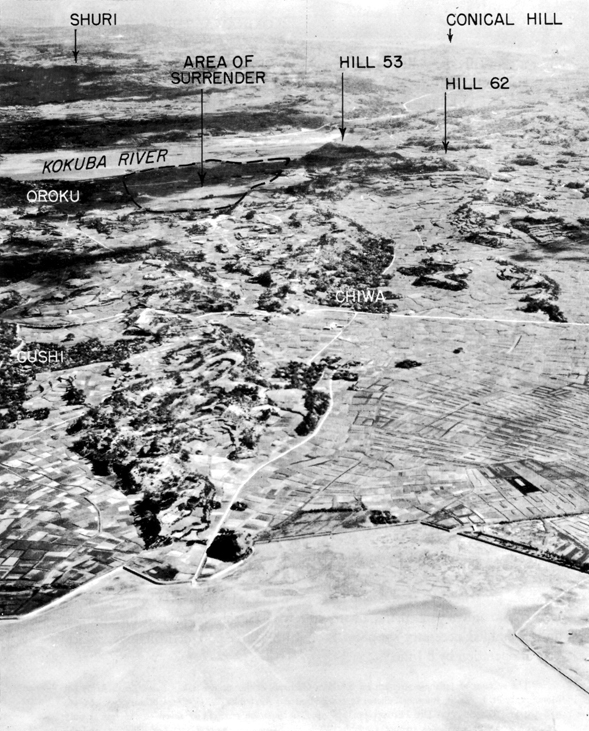
BASE OF OROKU PENINSULA, where Okinawa Base Force made its last stand 10 days after the Marine landing.
General Buckner, commanding US 10th Army, reduces the frontage of the US 3rd Amphibious Corps. The Marines have suffered the greatest losses, and the 6th Marine Division is stuck in a dogfight with the entrenched IJN base force on Oroku.
The IJA Kiyan line, 4 June 1945
The frontage for the US 24th Corps’ 7th and 96th Divisions are increased to make up for this.
Okinawa Campaign Background — Fighting the Mud Monster
No amount of words I write can say how bad the mud was at Okinawa the way that the following pictures do:
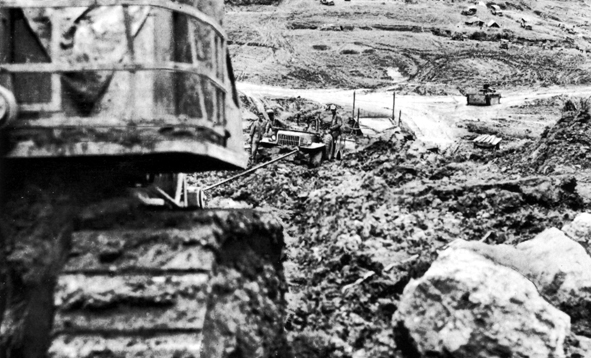
MUD AND SUPPLY were major problems in pursuing the Japanese southward from Shuri. Success depended largely on ability to move American supplies over bad roads. Tractor (above) is pulling a reconnaissance car uphill from portable bridge in the hollow.
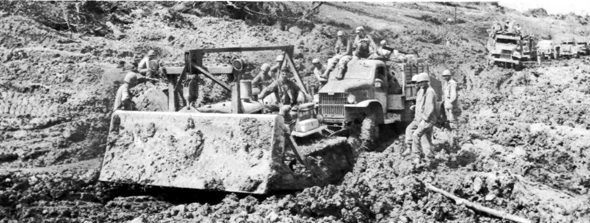
Supply trucks pulled through bad spot by 302d Combat Engineers
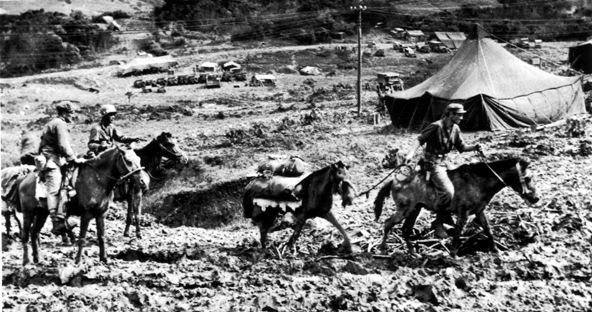
When roads became impassable to motor vehicles, horses were used.
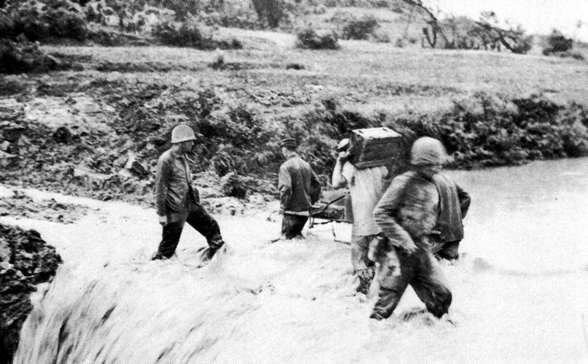
1st Division marines resort to hand carrying of supplies and wounded as roads are washed out by torrential rains.


As U.S. forces drew closer to the home Islands of Japan the resistance of the Japanese soldiers on the islands we invaded grew even more fierce and determined. On the main islands of Japan the military had amassed ten’s of thousands of troops, artillery pieces, airplanes, and were busy training civilians to resist to the very last. If Truman hadn’t dropped a couple of nuclear weapons o Japan which convinced the Emperor to end the war we would have had to invade. And the death toll, on both sides, would have been enormous.
From the Combined Arms Research Library Digital Library:
Japanese plans for the defense of Kyushu.
This report discusses the defensive plans of Kyushu, Japan, based on Sixth Army’s estimates and intelligence. The information was compiled for Operation Olympic, the invasion of Japan.
The report is dated 31 December 1945.
http://cgsc.cdmhost.com/cdm4/item_viewer.php?CISOROOT=/p4013coll8&CISOPTR=1148&CISOBOX=1&REC=15
My conclusion from reading “Downfall” is that an invasion would have been unsuccessful with a stalemate had the bombs not been available. The great typhoon of October would have hit the landing fleet exposed and great damage would have resulted. The Japanese had 12,000 airplanes hidden for Kamikazi use after the invasion.
One factor often ignored in the discussion is the tremendous difficulty of shifting the troops from Europe. Among other factors was the “point system” which would have sent the most experienced officers and noncoms home and excluded them from the invasion force. The result would have been a largely green army for the invasion.
An alternative to invasion would have been the submarine starvation plan combined with B 29 fire raids. Japan was lucky the bomb was available.
Another point ignored in most discussion is the fact that Japan had its own nuclear program with assistance from the Germans. After the first bomb, the Japanese scientists told the Emperor that we could not have enough U 235 for a second bomb and recommended continued resistance. The second bomb convinced them that we had unlimited ability to destroy them and they changed, or at least the Emperor did. That second bomb was the Plutonium bomb which they had not anticipated. They were right about U 235.
>My conclusion from reading “Downfall” is that an invasion would
>have been unsuccessful with a stalemate had the bombs not been
>available. The great typhoon of October would have hit the
>landing fleet exposed and great damage would have resulted. The
>Japanese had 12,000 airplanes hidden for Kamikazi use after the
>invasion.
The Operation Olympic landings started at X-day minus 4 days, with X-day being 1 Nov 1945
MacArthur said it would take 30-45 days to make up those typhoon losses at Okinawa for the Olympic landings.
See this link for the damage the October typhoon caused:
http://www.history.navy.mil/faqs/faq102-6.htm
and this from wikipedia:
Typhoon Louise
Category 1 typhoon (SSHS)
Duration October 2 – October 12
Intensity 120 km/h (75 mph) (1-min)
Louise was first seen developing on October 2 in the Caroline Islands. It unexpectedly veered north and slowed down, only to intensify as it passed over Okinawa with 90 mph wind gusts and a minimum central pressure of 968.5 mbar. Shortly after, Louise began to weaken, and hit Japan as a strong tropical storm. The tropical cyclone became extratropical shortly after on October 12. In Okinawa, 36 people died, 47 people were reported missing, and 100 people were seriously injured. In Buckner Bay, 30-35 waves were reported to have crashed ashore, tearing into the Quonset huts and other building. 12 ships were sunk, 222 ships were grounded, and another 32 were severely damaged. 80% of the buildings in the bay were completely wiped out while all 60 airplanes at the local airports were damaged, but most were repairable. 107 amphibious craft (including the wrecking of four tank landing ships, two medium landing ships, a gunboat, and two infantry landing craft) were grounded and damaged.[2]
Thus we would have gone in between 01-15 Dec 1945.
The biggest issue of the landings was not the ground defenses, it was the Kamikaze.
The answer to that problem was going to be US Army Chemical Warfare Service and US Navy smoke screens over the landing areas, amphibious shipping and radar pickets.
See:
THE CHEMICAL WARFARE SERVICE: CHEMICALS IN COMBAT
Brooks E. Kleber, Dale Birdsell
U.S. Army in World War II
CMH Pub 10-3, Cloth
1965, 2003
Chapter 10
http://www.archive.org/details/chemicalwarfares00kleb
and
Transport Doctrine
Amphibious Forces U.S. Pacific Fleet
September 1944
Chapter XXX
Use of Smoke in Amphibious Operations
http://www.ibiblio.org/hyperwar/USN/ref/Transport/transport-30.html
@MilTech bard;
What about the problems with the point system and transferring the army from Europe ?
The point system would be more of a problem for Coronet than Olympic and it would not be that much of a problem for Olympic.
Olympic would be reliant on Pacific Theater Army and Marine ground units and they operated far differently than the European and Italian theater US Army units.
Pacific theater ground units in the Central Pacific went into combat operations with very few replacements compared to ETO and MTO US Army units.
Division sized units were at 75% strength at the end of operations with the line infantry battalions in the final battles at 30% or less full strength — including replacements — at the end of Pelilu, Iwo Jima and Okinawa.
The SWPA was even worse. The entire Sixth Army got 5600 replacements during the entire six month Philippines campaign and the majority of them were not infantry.
Were it not for the Philippine guerrillas, the
US Army would have been in real trouble in the Luzon campaign holding the terrain it took against Japanese infiltration.
The point system was background noise compared to the problems of the existing infantry replacement system for Pacific combat units. When you were taking 150% casualties in line infantry battalions, the organizational chaos of the existing WW2 US Army individual personnel replacement system made the point system small beer in comparison.
The point system effects would be seen most on Pacific artillery and armor units, and there were still units arriving in the Pacific of both types that had never seen combat — particularly three airborne light tank battalions converted to Sherman’s and the new 8-inch howitzer, 8-inch gun and 240mm howitzer battalions that were coming for Olympic.
Heck, the entire Hawaii based 98th Infantry division had never seen combat.
It’s associated 767th Tank battalion was disbanded in the Philippines due to casualties. The 767th Battalion flag and lineage “Minus men and equipment” moved to Hawaii, and four M4 Sherman tank companies from two other disbanded tank battalions (that were never fully staffed) were slammed together under that flag and would land in Japan as three M26 Pershing and one M24 Chaffee tank companies!
Heck, the entire Hawaii based 98th Infantry division had never seen combat.
My dad was in the 98th. He told me they heard the news of the surrender while in transit to Saipan. He spent about 6 months in the occupation forces at Osaka before being demobilized.